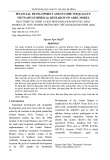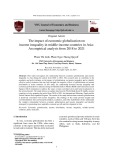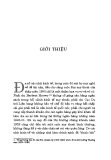
* Corresponding author.
E-mail address: Abbady.majdi@yandex.com (M. A. S. Abbady)
© 2019 by the authors; licensee Growing Science, Canada.
doi: 10.5267/j.dsl.2019.5.003
Decision Science Letters 8 (2019) 429–440
Contents lists available at GrowingScience
Decision Science Letters
homepage: www.GrowingScience.com/dsl
Big data governance, dynamic capability and decision-making effectiveness: Fuzzy sets
approach
Majdi Al Saaideh Abbadya*, Murat Akkayaa and Arif Saria
aGirne American University, Cyprus
C H R O N I C L E A B S T R A C T
Article history:
Received April 19, 2019
Received in revised format:
May 20, 2019
Accepted May 20, 2019
Available online
May 20, 2019
This article examines the nexus between Big data governance, dynamic capability and decision-
making. Survey data was garnered from firms in Jordan and fuzzy sets (fsQCA) approach was
applied. Fuzzy set configural modeling revealed two causal models for high decision-making
effectiveness conditions. First, Big data governance, number of employees and firm age are
necessary for higher levels of effective decision-making. Second, dynamic capability, number of
employees and firm age are necessary for higher levels of effective decision-making. Insights for
practitioners in an emerging economy and possible areas of future research are highlighted.
.2018 by the authors; licensee Growing Science, Canada©
Keywords:
Fuzzy set
Big data
Dynamic capability
Decision-making, Jordan
1. Introduction
With the rapid change in business operation and environment, it is necessity for firms to stay relevant
about what they need to anticipate and react to the changes proactively. Several studies discovered that
firms cannot realize effectiveness and high-performance if they lack the capabilities required to cope
with both external and internal changes (e.g., Fainshmidt et al., 2016; Mikalef & Krogstie, 2018; Teece,
2007; De Haes & Van Grembergen, 2015). Dynamic capabilities are defined by Zollo and Winter
(2002, p. 340) as an array of a number of collective activities that are both stable and learned by which
an organization systematically modifies and/or generates its operational routines in a quest to improve
effectiveness. Helfat et al. (2009, p. 4) described dynamic capabilities as an organization’s capacity to
modify, extend or create its operational competencies purposefully.
According to (Teece, 2007), dynamic capabilities “is a firm’s complex and tough-to-replicate
capabilities of sensing, seizing and reconfiguration necessary for adapting to changing technological
opportunities and customer need”. Researchers such as Karna et al. (2016) claim that dynamic
capabilities ought to line up with technologies used, and other organizational factors to achieve success
in any organization. In addition, while dynamic capability is essential for successful survival in a
dynamic business environment (Pezeshkan et al., 2016; Teece, 2007). Weber et al. (2009) opines that,
for a firm to achieve its agility objectives and for it to meet the requirement of changing business
environment, high-quality data is a prerequisite for such firm. Hundred (100) Petabytes (PB) of data

430
are processed by Google and Facebook, and Terabyte (TB) by Alibaba and its subsidiaries (Chen et al.,
2014).
This argument brings Big data into the picture, it denotes huge datasets. It comes with fresh
opportunities for the discovery of new values, supports us in gaining a better understanding of values
that have been hidden, as well as invites new challenges, such as the effective managing and organizing
of such enormous datasets (Abubakar et al., 2017; Chen et al., 2014). Mikalef and Krogstie (2018)
argued that big data usage by contemporary firms is a strategic tool that yields superior business value.
According to Weber et al. (2009), Big data governance comprises of different activities involving
decision-making for data quality management; and the allocation of responsibilities (structural
practices), the decision-making process (procedural practices), as the relational responsibilities and
links between departments (relational practices).
Shamim et al. (2018) proposed that the management of big data is the major antecedent in decision-
making and it is also essential to the quality of decision. Because managers and analysts are provided
with a powerful set of tools for data visualization, data mining and data analysis (Davenport & Harris,
2017). Only very little empirical research has been carried out in this area (Mikalef & Krogstie, 2018).
To date, several emphases have been on dynamic capability, with little attention to big data
governance and on how both variables affect decision-making effectiveness of firms. To this end,
this paper aims to grasps how effective decision making in a firm can be influenced by big data
governance and dynamics capability.
2. Hypotheses development
Big data as large data volume that is beyond the current on-line technological capacity to process,
manage and store efficiently. Big data is high-velocity, high-variety and high-volume information that
require state-of-the-art and cost-effective forms of information processing for improved decision-
making and insight (Gandomi & Haider, 2015). Lee (2017) suggests that value, volume, velocity,
veracity and variety are big data dimensions. According to Mikalef and Krogstie (2018), an increasing
number of firms are investing heavily in big data, with the sole aim of gaining a competitive edge over
other firms. It was also added that many researchers and practitioners have associated the next big
frontier for productivity, competitiveness, and innovativeness to big data. Günther et al. (2017) in their
research opined that firms that are dependent on big data to guide their daily operation and
organizational strategies are estimated to perform financially better than other firms that do not. This
is because, decision making is enhanced, and strategizing is more informed through big data utilization
(Günther et al., 2017). Similarly, the capacity a firm possesses to incorporate, develop and reconstruct
its external and internal competences when dealing with swiftly changing environments. This allows
them gain competitive advantage
2.1. Dynamic capability and effective decision-making
Effective decision making requires constant scanning, searching, and exploring markets intelligence
and technology. Existing literature suggest that the capacity of organizations in managing information
has an impact their performance, process management and customers service delivery through
effectiveness of decisions made based on information available to it (Mithas et al., 2011). Wamba et
al. (2017) argued that it is a game changer that facilitates effectiveness due to its great strategic and
operational potential in the decision-making process. Thus, dynamic capabilities can help organizations
identify threats and opportunities (Wilhelm et al., 2015), which allow firms to implement the right
responses to their environment and thus improving the relevance of their decisions. The dynamic
capability of sensing opportunities and threats includes collecting and filtering competitive market and
technological information for decision-making. Sensing is essential, but it is insufficient for effective
decision making. Once a quality diagnosis is made as a result of sensing, the dynamic capability of

M. A. S. Abbady et al. / Decision Science Letters 8 (2019)
431
seizing comes in to facilitates the implementation of organizational change and strategic action plans
(Torres et al., 2018). The third component transforming, entails executing organizational decisions via
the revamping of organizational routines, the realigning of assets and the restructuring of the business
model (Teece, 2007). Thus, dynamic capabilities influence the effective decision making not just in the
aspect of making correct decisions in response to the prevailing circumstances in the business
environment but also in ensuring promptness in implementation.
H1: Dynamic capabilities have significant impacts on decision-making effectiveness.
2.2. Big data governance and effective decision-making
Research has shown that big data governance is likely to result in performance. Big data governance
has ushered significant changes in modern establishments particularly in the procedures of decision-
making (Janssen et al., 2017). Through enhancement of managerial decisions quality and future
forecasting (Kung et al., 2015). Firms that employ data and business analytics are more likely to be
productive, make right decisions and boost their revenues in comparisons to competitors that don’t
(Brynjolfsson et al., 2011). Big data analytics have the potential to extensively minimize risks and
improve decision making (Manyika et al., 2011). At best the decisions are made based on experience
and the intuition of decision makers. Using big data, managers are enabled to decide based on evidence
instead of intuition and this has the perspective to entirely reform management (McAfee &
Brynjolfsson, 2012). Decision making will never remain the same as certain organizations are already
making decisions that are effective by analyzing complete datasets from staffs, customers or even
sensors implanted in products (Manyika et al., 2011). Based on the extant discussion the following
hypothesis is proposed:
H2: Big data governance has a significant impact on decision-making effectiveness.
2.3. Demographic variables effects
Research denote that smaller firms are not likely to profit as much due to the scale and scope economies
in applying dynamic capabilities (Arend, 2014). The role organizational size plays have been studied
as a contingency factor in several types of research in Information System (IS) activities such as data
governance and analytics (Raymond & Bergeron, 2008). Thus, larger firms the more likely will the
managers establish formal structures and processes to ensure IS activities including data analytics. On
the other hand, it has been reported that smaller organizations are more likely to be well aligned in data
analytics and its application due to the greater degree of communication that exists between people in
the smaller organizations but in larger organizations, realizing such alignment appears to be a laborious
undertaking (Chan et al., 2006). Mikalef et al. (2015) reported smaller firm size increases the chances
of business benefiting from IS activities in strategic purchase decision making. Chan and Reich (2007)
argued that data analytics are best applied if firm size is small. Contrariwise, bigger firms have the
financial capability to invest and govern big data better that smaller firms (Chan et al., 2006).
Additionally, enormous amounts of data makes it difficult for younger and inexperience firms to
leverage the benefits of dynamic capability and Big data (Carayannopoulos, 2009). Subsequently, there
was a report, which indicates that employees in smaller firms are more motivate than those in bigger
and older firms (Arend, 2014). The ambiguity in the findings of previous studies made use to propose
the following hypotheses;
H3: Dynamic capability interacts with firm type (based on employee number) and firms age to predict
higher levels of decision-making effectiveness.
H4: Big data governance interacts with firm type (based on employee number) and firms age to predict
higher levels of decision-making effectiveness.

432
3. Materials and methods
3.1. Research Instruments
Dynamic capability - operationalized as a triad second-order construct namely: sensing, seizing and
transforming with (3-items) each (Teece 2007; Jantunen et al., 2018) work. Sample of item include
“We frequently scan the environment to identify new business opportunities”. Big Data governance -
operationalized as a triad second-order construct namely: structural, procedural and relational practices
(Mikalef & Krogstie, 2018). Structural (2-items), relational (2-items) and procedural (5-items) practices
Sample of item include “in our organization, we have controlled practices regarding data management
in terms of establishing/monitoring access (e.g., user access) to data”. Decision-making effectiveness
–operationalized with 3-items (Wang & Byrd, 2017). Sample of item includes “The speed at which we
analyze decisions has increased with the use of business analytics systems and strategies”. The
response options were anchored on the five-point Likert scale where 1 = “strongly disagree” and 5 =
“strongly agree”.
3.2. Sampling technique and procedure
The scale items were adapted from prior works. The items were back-translated by linguistic experts
from English to Arabic and vice versa as applicable in prior studies (i.e., Abubakar et al., 2018);
followed by a pre-test to evaluate the appropriateness and the presence of ambiguity in wordings and
sentence structure. As a next step, we assured the participants of anonymity and confidentiality to
reduce common method bias (Podsakoff et al., 2012). The participants are top managers working in
several industries (i.e., manufacturing, service, IT & telecommunication, hotel and hospitality and oil,
gas and mining) in Jordan. This study deployed simple random sampling (SRS) technique because of
its unbiasedness and aptness to tranquillize classification error (Jahmani et al., 2018). Moreover, with
this sampling techniques firms in the whole population have equal chance of being selected, more
specifically, any firm can be sampled without bias.
3.3. Fuzzy sets (fsQCA)
Complexity theory posits the total net effects of a predictor variable on a response variable is hardly
precise nor error-free. This largely because “prediction of behavioral outcomes is a complex process, a
set of complex interactions between antecedents (i.e. conjunctural causation) must be considered as a
causal model capable of predicting the conditions leading to a desired outcome”. Fuzzy set (fsQCA)
uses a distinct configuration of causal antecedents to predict response variable. In linear modeling
predictors X1, X2 and X3 are expected to predict Y, whereas, in fsQCA the predictor variables are
combines either X1 and X2, or X1 and X3, or X2 and X3 to predict Y (Olya & Gavilyan, 2016; Ragin,
1987).
4. Data analysis and results
4.1 Demographic information
A breakdown of the demographic data are presented in Fig. 1 and the descriptive statistics are presented
in Table 1.

M. A. S. Abbady et al. / Decision Science Letters 8 (2019)
433
Number of employees Industry
Firm age Department
Fig. 1. Personal characteristics of the participants
The proposed configurational model was tested using fsQCA software (Ragin, 2008; Woodside, 2013).
This study uses a five-point scale, which makes the scale more suitable to calibrate it into Fuzzy set
membership. Following Ragin’s (2008) recommendations the calibration process was carried out,
where 1.00 (full membership), 0.5 (crossover point) and 0 (full non-membership). In this study the
calibration process below was used to convert the scale into Continuous Fuzzy sets.
Calibrate(x,n1,n2,n3)
where
x depicts the variable to be transform, n1 is the full membership range set to 4, n2 is the crossover point
set to 3 and n3 is the full non-membership set to 2
Computational formula is given:
compute: cBigDataGovernance = calibrate (BigDataGovernance,4,3,2)
100
82
67
>50 50--100 <100
43
70
47
31
58
Manufacturing Service
IT&Telecommunication HotelandHospitality
Oil,GasandMining
53
71
65
60
>1 1--5 6--10 <10
63
58
58
60
Research&development Marketing&sales
Operations HumanResources










![Tài liệu về Tiền Chủ Nghĩa Tư Bản và Kinh Tế Tiền Tư Bản [Mới Nhất]](https://cdn.tailieu.vn/images/document/thumbnail/2010/20101110/hoangkha04/135x160/tien_chu_nghia_tu_ban_va_kinh_te_tien_tu_ba1_2154.jpg)















